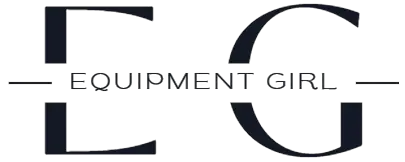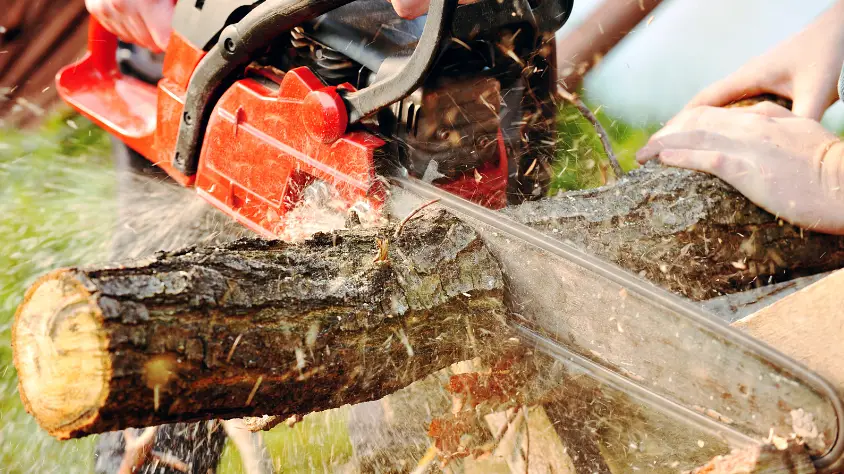If your chainsaw has stopped cutting straight, it can be a serious frustration. Most woodworking projects require a smooth, straight line when you cut, so if your chainsaw won’t cut straight, your projects can all take quite the hit.
There are many probable reasons why your chainsaw is not cutting straight. From the cutter teeth to the chainsaw bar, or the chainsaw chain’s tension to the chain width being inappropriate, the likely causes are many.
To help clear things up, though, we’ll take a look at why your chainsaw is not cutting straight today, and even give you the fixes for each problem so you can get back to cutting straight again before you know it!
How To Know If Your Chainsaw Isn’t Cutting Straight
The most obvious sign that your chainsaw is not cutting straight is after you’ve finished cutting and notice that the wood you were working on is crooked. By then, it’s usually too late to save the piece of wood you’re working on, which is why we’d always recommend cutting a practice bit of wood first, in case the chainsaw doesn’t cut straight.
You might also notice that the chainsaw is pulling to one side instead of cutting straight through the wood in one direction. This will result in a crooked or curved line by the time you’ve finished cutting, and it often feels obvious as you’re working.
List Of Potential Causes
Typically, the reason your chainsaw stops cutting straight is due to poor maintenance of the chainsaw. A chainsaw can’t cut straight if the proper routine blade maintenance and chain maintenance isn’t carried out.
A chainsaw cuts crooked when you’ve failed to care for it properly, and the problem is usually one of five:
- The chainsaw chain cutting teeth aren’t properly sharpened
- Your chainsaw chain tension is incorrect, making it too loose
- The chain width is incorrect when you replace your old chain with a new chain
- Chainsaw bar groove is worn
- The chainsaw bar rail is worn
As you can see, it’s typically chainsaw chains and chainsaw bars that are causing your chainsaw to not cut straight. Below, we’ll explain more about each problem and give you the solution too!
Problem 1: Chainsaw Chain Isn’t Sharp
A dull chain, where the cutter teeth aren’t sharp enough to do the job of cutting through wood properly, will almost always cause your chainsaw to not cut straight.
A sharp chain hits the wood perfectly, because when sharpened properly, both sides of the cutter tooth are perfectly balanced and are the same size – and the tooth length of each tooth along the chain is the same too.
But when there’s a dull chain, the chainsaw will cut crooked because of longer teeth on one side of the chain. The sharp side of the chain will pull the chainsaw in that direction, leading to an uneven cut.
If your chainsaw is not cutting straight suddenly, it may be that your chainsaw hit a rock or something hard when last in use, wearing down one side of the chain quicker than the other because the pressure on both sides isn’t the same amount. If your chainsaw hasn’t been cutting right for a while, it may be due to uneven sharpening. Either way, the solution to the problem as a whole is to sharpen your chain.
Solution: Sharpening The Chain
To fix the issue, you need to keep the chain sharp! Here’s how to do it:
- Check the cutter teeth – there should be a line on each one where you can’t sharpen it past that point (if you can’t see the line, you’ll need a replacement chain because it’s already sharpened past the point of no return). If you can see the small line, it works as a great guide to see how much larger some of the teeth are than others. You’ll need to sharpen the taller teeth, usually down one side of the chain.
- Next, gather your equipment – you’ll need a round flat file and a file guide to help stop lopsided sharpening.
- Fix your chainsaw in place – you need it to be held still whilst sharpening. You can also add a drop of oil to the carbide shaft here to ensure it can spin freely for an easier time whilst sharpening.
- Now, file the teeth – apply equal pressure as you work at a 30-degree angle on each tooth that needs filing, being sure to only ever file in the same direction – grinding it back and forth will damage the delicate tooth. Push firmly with the same pressure on each tooth to avoid an uneven chain on one side. You can use an adjustable wrench to check the height of each tooth is correct.
- Finally, adjust the depth gauges – use a depth gauge tool and a flat file to adjust the depth of the gauge to the right amount according to the tool. This controls the cutting depth. Consult your user manual for more information if you’ve never done this before.
After following these steps, the teeth will be sharp enough to cut straight when the chainsaw is next in operation.
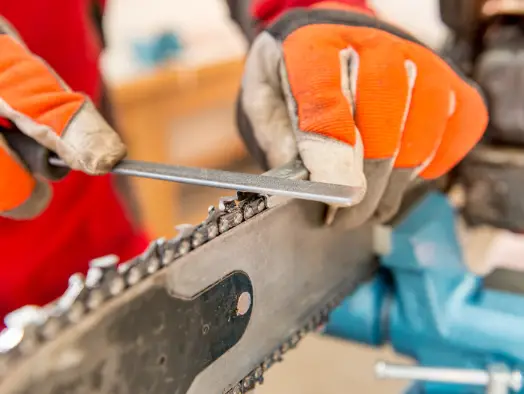
Problem 2: Loose Chainsaw Chain
Most chainsaws come with a tension screw that helps tighten the chainsaw chain around the saw bar. You need to make sure that it is tightened just so – too loose and it won’t cut straight, too tight and the chain can be damaged.
If you notice that your chainsaw isn’t cutting straight, then it may be due to a loose fitting chain, meaning you’ll need to tighten it to fix the issue.
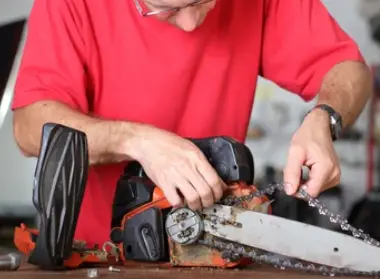
Solution: Tightening The Chain
You need the chain to fit snugly on the guide bar to work effectively and cut straight. To do this, you’ll need to tighten the chain by twisting the tension screw until it’s tight enough to fit over the bar perfectly.
If, after tightening, the chain still sags a little, then the chances are you have the wrong chain size for your chainsaw. You’ll need to purchase a replacement chain if you’ve bought the wrong one, or else remove a cutter link or two until it can fit the bar correctly.
Problem 3: Chain Width Is Wrong
Take a look at your chain. You should notice that it has tooth-shaped drivers that fit into the bar’s groove to hold it in place. If the thickness of the chain groove is less than the bar’s groove, then it won’t be able to stay in place.
Instead, the chain wiggles and the chainsaw will shift sideways in operation. When the groove chain’s thickness is less than the bar groove’s width, the chain will wiggle around. To fix this, you’ll need a replacement chain.
Solution: Getting The Chain Thickness Right
If you’ve noticed that the chain thickness is wrong for the bar’s groove because it’s too thin, then you’ll simply need to check your user manual to see what the correct chain width is for your chainsaw.
It’s typically around 5/8 inch, but it’s always best to consult your manual for the correct size because different manufacturers may vary.
Once you find out the original width intended for your chainsaw chain, purchase a new one and mount it to the bar. This should stop uneven cuts.
Problem 4: Chainsaw Bar Grooves Are Worn
If you get the chain’s width right, there can still be problems with where the bar groove and chain grooves meet. Your chainsaw will still cut crooked even if you have the right width for your chain if the bar grooves are all worn.
When a bar groove is worn, the chain grooves can’t connect and stay at the correct angle when in operation, causing the chainsaw to wiggle and an angled cut you weren’t hoping for. Typically, it will be the lower side of the bar groove that has worn from where it has been hitting wood and taking the brunt of the friction and tension.
Solution: Flip It
To fix the issue, you won’t need a replacement bar just yet. If this is the first time you’re noticing this problem, then you can simply flip the bar over entirely and then mount the chain on it again.
The bar grooves on the other side of the bar won’t be worn, so the fresher bar grooves will now be able to connect to the chain grooves effectively and hold it in place, helping you cut straight.
You can only use this trick once, though. Once the fresh side of the bar grooves wear down, you’ll need to replace the bar entirely.
Problem 5: Bar Rails Wear
Rails are the two edges that form the bar’s groove, and uneven rails occur naturally over time as they wear down from continued use.
If this happens, though, the chain will sit unevenly on the rails, leading to a crooked cut when you use the chainsaw.
Solution: Grind Down The Chainsaw Bar Rails
The solution to this problem is straightforward: you’ll need to file down one side of the rail that’s taller than the other until they sit evenly.
You could use a powered grinding tool to get the job done if you have one available to you, or else use your dominant hand, a file, and a bench wise to hold it evenly in place as you work.
Grind/file down the rails until they’re even, and then remount the chain to the bar. It should now be cutting straight.
Bonus Problem: Chainsaw is Still Cutting Crooked
If, after trying the solutions to the above five problems, your chainsaw is still not cutting in the way it ought to, then you’ll need to think of a new solution…
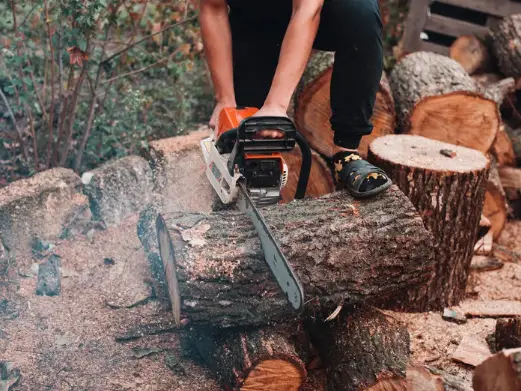
Solution: Seek Professional Help
It may be that you’ve not quite fixed one of the problems above yourself, or maybe the problem is something else entirely. Either way, if you’re still having trouble with your chainsaw at this point, it’s best to take it to a professional in a saw shop.
Here, they’ll be able to check everything and set the record straight about the issue with your chainsaw and fix it for you there and then. Thanks to a professional’s checks, you ought to be cutting straight again in no time.
A Final Note On Maintenance
Hopefully, today’s post has shown you that fixing a chainsaw that doesn’t cut straight is pretty easy. And if all else fails, you can take it to a professional to fix the issue for you, as mentioned earlier.
To avoid these issues in the future, though, you should keep up with regular maintenance yourself at home. That means keeping your chainsaw bar clean, removing dirt caught in bar grooves, keeping the oil hole on both sides of the bar clean of old bar oil, and ensuring everything is working as it should, by checking the chain sharpness and tension, bar grooves, and rails regularly so you can fix any issues early as they arise.
